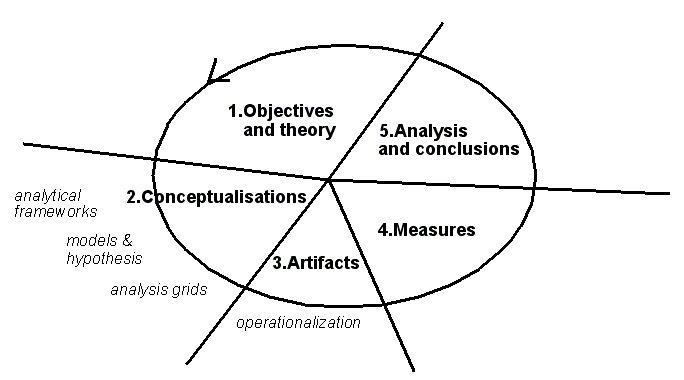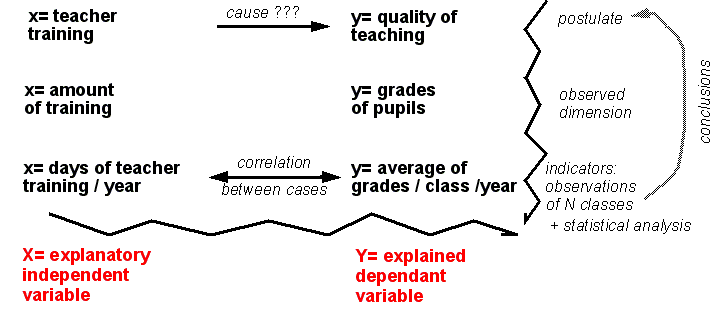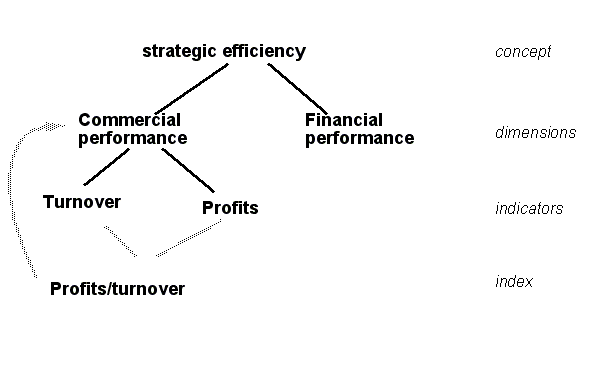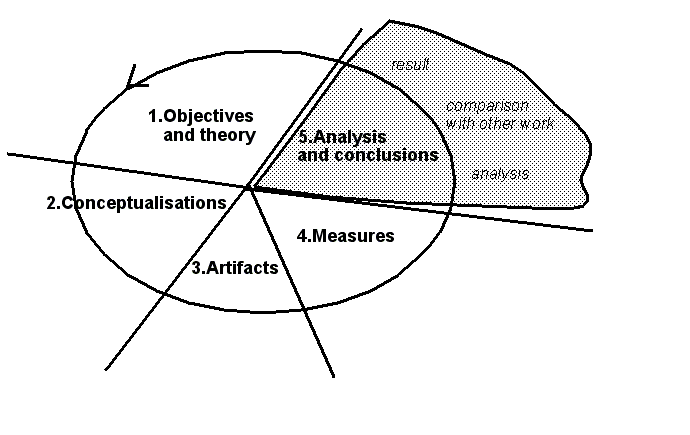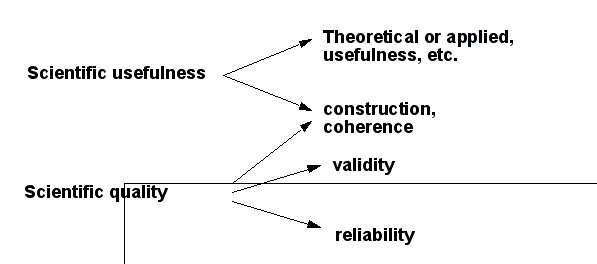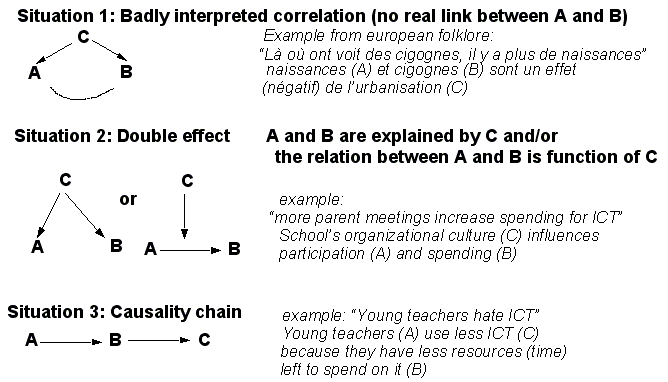Methodology tutorial - empirical research principles: Difference between revisions
m (using an external editor) |
|||
| Line 2: | Line 2: | ||
<pageby nominor="false" comments="false"/> | <pageby nominor="false" comments="false"/> | ||
This is part of the [[methodology tutorial]]. | |||
== Introduction == | |||
<div class="tut_goals"> | |||
; Global aim | |||
* Acquire an understanding of some principles that define empirical research | |||
; Learning goals | |||
* Understand the central role of research questions | |||
* Know the elements of a typical research process | |||
* Understand "operationalization", i.e. the relation between theorectical concepts and measures (observations, etc.) | |||
* Be able to list some major measurement instruments | |||
* Understand the concepts of reliability and validity | |||
; Prerequisites | |||
* None, but it is recommend to read [[Methodology tutorial - introduction]] module first | |||
; Moving on | |||
* [[Methodology tutorial - finding a research subject]] | |||
# [[Methodology tutorial - the research plan]] | |||
; Level and target population | |||
* Beginners | |||
; Quality | |||
* There should be links to real research | |||
</div> | |||
=== Elements of a typical research cycle === | === Elements of a typical research cycle === | ||
Details of a given research cycle may considerably change within a different approaches. However, most research should start with a an activity that aims | |||
to define precise research questions through both a review of the literature and reflections about the objectives. We shall come back to these issues in this and | |||
later modules. | |||
[[Image:book-research-design-37.png]] | [[Image:book-research-design-37.png]] | ||
| Line 14: | Line 38: | ||
=== Key elements of empirical research === | === Key elements of empirical research === | ||
For a given research question, you usually do: | For a '''given research question''', you usually have to do: | ||
[[Image:book-research-design-38.png]] | [[Image:book-research-design-38.png]] | ||
* '' | * What we call ''conceptualisations'': make questions explicit, identify major concepts (variables), define terms and their dimensions, find analysis grids, define hypothesis, etc, | ||
* '' Artifacts'' : develop research materials (experiments, surveys), implement software, etc. | * Develop ''Artifacts'' : develop research materials (experiments, surveys), implement software, implement designs in the field, etc. Artifacts can be made just for research purposes (e.g. in experimental research) or for "real" purposes (e.g. a computer-supported learning environment for a precise training need) | ||
* '' Measures'' : Observe (measure) in the field or through experiments | * Do '' Measures'' : Observe (measure) in the field or through experiments. ''Use'' your artifacts in various ways) | ||
* '' Analyses & conclusion'' : Analyze the measures (statistic or qualitative) and link to theoretical statements (e.g. operational research questions and hypothesis) | * Do '' Analyses & conclusion'' : Analyze the measures (statistic or qualitative) and link to theoretical statements (e.g. operational research questions and hypothesis). Finally finish writing it up. | ||
== Objectives == | == Objectives == | ||
Now let's start looking at research objectives, i.e. the starting point of a research project. The '''essence''' of your research objectives should be formulated in terms | |||
of clear research questions. | |||
[[Image:book-research-design-39.png]] | [[Image:book-research-design-39.png]] | ||
| Line 34: | Line 61: | ||
Everything you plan to do, must be formulated as a research question ! | Everything you plan to do, must be formulated as a research question ! | ||
See [[Methodology tutorial - finding a research subject]], where we will elaborate this question in some more detail | |||
== Conceptualizations == | == Conceptualizations == | ||
Under the umbrella "conceptualizations" we define a whole lot of intellectual instruments that help you organize theoretical and practical knowledge about | |||
your research subject. | |||
So one of your first task is find, elaborate and "massage" some concepts so that they can be used to study observable phenomena. Some of these concepts may globally determine how you look things, others are more like explanatory or to be explained variables. | |||
We shall come back to this issue in the [[Methodology tutorial - conceptual frameworks]] and just provide a few examples here. | |||
[[Image:book-research-design-40.png]] | [[Image:book-research-design-40.png]] | ||
| Line 44: | Line 76: | ||
=== The usefulness of analysis frameworks === | === The usefulness of analysis frameworks === | ||
Analysis frameworks help you look a things. | |||
One popular framework in educational technology research is [[activity theory]] which has its roots in what could be called sowjet micro-sociology. | |||
[[Image:Activity-theory.gif]] | [[Image:Activity-theory.gif]] | ||
Quote: The Activity Triangle Model or activity system representationally '' outlines the | Quote: The Activity Triangle Model or activity system representationally '' outlines the various components '' of an activity system into a unified whole. ''Participants in an activity are portrayed as subjects interacting with objects to achieve desired outcomes''. In the meanwhile, human interactions with each other and with objects of the environment are '' mediated through the use of tools, rules and division of labour.'' Mediators represent the nature of relationships that exist within and between participants of an activity in a given community of practices. This approach to modelling various aspects of human activity draws the researcher s attention to factors to consider when developing a learning system. However, activity theory does not include a theory of learning, (Daisy Mwanza & Yrjö Engeström) | ||
various components '' of an activity system into a unified whole. '' Participants in an | |||
activity are portrayed as subjects interacting with objects to achieve desired outcomes'' | * Translation: Il helps us thinking the working of an organization (including its actors and processes) and therefore how to study it. | ||
. In the meanwhile, human interactions with each other and with objects of the environment | * Such a framework is not true or false, just ''useful'' (or useless) for a given intellectual task ! | ||
are '' mediated through the use of tools, rules and division of labour.'' Mediators | |||
represent the nature of relationships that exist within and between participants of an | === Hypothesis and operationalizations === | ||
activity in a given community of practices. This approach to modelling various aspects of | |||
human activity draws the researcher s attention to factors to consider when developing a | |||
learning system. However, activity theory does not include a theory of learning, (Daisy | |||
Mwanza & Yrjö Engeström) | |||
* | Models and hypothesis are important in theory-driven research, e.g. experimental learning theory. | ||
* | |||
* These constructions link concepts-as-variables and they ''postulate causalities'' | |||
* Causalities between theoretical variables do not "exist" per se, they only ''can be observed indirectly''. Working with hypothesis will need operationalization as we shall see. | |||
* Typical statements: "More X leads to more Y", "an increase in X leads to a decrease in Y | * Typical statements: "More X leads to more Y", "an increase in X leads to a decrease in Y | ||
Example: We have a research question that want's to know whether there is a causality between teacher training and quality of teaching. In empirical research such a research questions whould be formulated as a hypothesis that then can be tested. | |||
An often head hypothesis would state the following: | |||
teaching ('' Y'' ) | * Continuous teacher training (''cause X'') improves teaching (effect ''Y'') | ||
In the picture below we can show the following principles: | |||
* As a starting point we need a causal hypothesis (the postulate) | |||
* We then have to think how to measure each of the two concepts with observable data. E.g. teacher training could be measured by the "amount of training" and quality of teaching by "grades of pupils". | |||
* However, this operationalization is not enough. At some point we have to be more precise, e.g. state that "amount of training" will be measured by "days of training received in one year". | |||
[[Image:book-research-design-42.png]] | [[Image:book-research-design-42.png]] | ||
We shall come back later to this central concept of '''operationalization'''. The point here was to show that hypothesis should be formulated firstly at a conceptual level. They they need to be rephrased to become operational, i.e. applicable to real data. | |||
=== The importance of difference (variance) for explanations === | === The importance of difference (variance) for explanations === | ||
Before we further look into this operationalization issue, we need to introduce the "variance" concept. Variance means that things can be different, e.g. teachers can receive {none, little, some, a lot, ...} of training. So we got a variable "amount of teacher training" that can have different values (none, little, etc.). If we can find this variety of values in observations we have variance. If all teachers receive ''some'' training we don't have variance. Research needs variance. Without variance (no differences) we can't explain things. | |||
Further more we need co-variance. Since empirical research wants to find out '''why things exist''', we must observe explaining things that have "more" and "less" and how they impact on things to be explained that have "more or less". In other words, without co-variance ... no explanation. | |||
Let's explain this principle with two examples | |||
; (1) Quantitative example | ; (1) Quantitative example | ||
| Line 94: | Line 130: | ||
Imagine that we wish to know why certain private schools introduce technology faster than | Imagine that we wish to know why certain private schools introduce technology faster than | ||
others. One hypothesis to test could be: "Reforms | others. One hypothesis to test could be: "Reforms happens when there is external pressure". | ||
So we have two variables (and according values) | |||
* reforms (happen, don't happen) | |||
* pressure (internal, external) | |||
To operationalize these variables we use written traces for "pressure" and observable actions for "reforms". | |||
{| border="1" | {| border="1" | ||
! rowspan="1" colspan="1" | | ! rowspan="1" colspan="1" | | ||
! rowspan="1" colspan="4" |Strategies of a school | |||
! rowspan="1" colspan="4" | | |||
Strategies of a school | |||
|- | |- | ||
! rowspan="1" colspan="1" | | ! rowspan="1" colspan="1" |Type of pressure | ||
Type of pressure | ! rowspan="1" colspan="1" |strategy 1:no reaction | ||
! rowspan="1" colspan="1" | | ! rowspan="1" colspan="1" |strategy 2:a task force is created | ||
strategy 1:no reaction | ! rowspan="1" colspan="1" |strategy 3:internal training programs are created | ||
! rowspan="1" colspan="1" | | ! rowspan="1" colspan="1" |strategy 4:resources are reallocated | ||
strategy 2:a task force is created | |||
! rowspan="1" colspan="1" | | |||
strategy 3:internal training programs are created | |||
! rowspan="1" colspan="1" | | |||
strategy 4:resources are reallocated | |||
|- | |- | ||
| rowspan="1" colspan="1" |Letters written by parents | |||
| rowspan="1" colspan="1" |(N=8)'' (p=0.8)'' | |||
| rowspan="1" colspan="1" |(N=2)'' (p=0.2)'' | |||
| rowspan="1" colspan="1" | | | rowspan="1" colspan="1" | | ||
| rowspan="1" colspan="1" | | | rowspan="1" colspan="1" | | ||
|- | |- | ||
| rowspan="1" colspan="1" |Letters written by supervisory boards | |||
| rowspan="1" colspan="1" | | | rowspan="1" colspan="1" | | ||
| rowspan="1" colspan="1" |(N=4)'' (p=0.4)'' | |||
| rowspan="1" colspan="1" |(N=5)'' (p=0.5)'' | |||
| rowspan="1" colspan="1" |(N=1)'' (p=0.1)'' | |||
| rowspan="1" colspan="1" | | |||
(N= | |||
| rowspan="1" colspan="1" | | |||
(N= | |||
| rowspan="1" colspan="1" | | |||
|- | |- | ||
| rowspan="1" colspan="1" |newspaper articles | |||
| rowspan="1" colspan="1" | | | rowspan="1" colspan="1" | | ||
| rowspan="1" colspan="1" | | | rowspan="1" colspan="1" | | ||
| rowspan="1" colspan="1" |(N=1)'' (p=20%)'' | |||
| rowspan="1" colspan="1" | | | rowspan="1" colspan="1" |(N=4)'' (p=80%)'' | ||
(N= | |||
|} | |} | ||
N = number of observations, p = probability | N = number of observations, p = probability | ||
The result of (imaginary) research is: Increased pressure leads to increased action. | |||
Data for example tells that: | |||
* If letters are written by parents (internal pressure), the probability is 80% that nothing will happen | |||
* If a newpaper article is written, the probability is 80% that resources are reallocated. | |||
Of course, such results have to interpreted carefully and for various reasons, but we shall come back to these validity issues in some other tutorial module. | |||
=== How can we measure general concepts ? === | === How can we measure general concepts ? === | ||
Now let's address the operationalization issue in more depth. | |||
A scientific proposition contains concepts (theoretical variables) | A scientific proposition contains concepts (theoretical variables) | ||
| Line 158: | Line 184: | ||
An academic research paper '''links''' concepts and and empirical paper grounds these links with data. | An academic research paper '''links''' concepts and and empirical paper grounds these links with data. | ||
* ... empirical research requires that you work with data, find indicators, build indices, | * ... empirical research requires that you work with data, find indicators, build indices, | ||
* because | * because we observe correlations in some data we can make statements at the theory level | ||
; Example: [[Collaborative learning]] improves '' pedagogical effect'': | ; Example: [[Collaborative learning]] improves ''pedagogical effect'': | ||
[[Image:book-research-design-46.png]] | [[Image:book-research-design-46.png]] | ||
| Line 170: | Line 196: | ||
* There are 2 issues you must address: | * There are 2 issues you must address: | ||
(1) Going from | (1) Going from ''abstract" to "concrete'' (theoretical concept - observables) | ||
Examples: | Examples: | ||
| Line 177: | Line 203: | ||
* measure of “pedagogical success” with “grade average of a class in exams” | * measure of “pedagogical success” with “grade average of a class in exams” | ||
(2) | (2) ''whole - part'' (dimensions): | ||
Examples from educational design, i.e. dimensions you might consider when you plan to | Examples from educational design, i.e. dimensions you might consider when you plan to | ||
Revision as of 17:39, 8 October 2008
<pageby nominor="false" comments="false"/>
This is part of the methodology tutorial.
Introduction
- Global aim
- Acquire an understanding of some principles that define empirical research
- Learning goals
- Understand the central role of research questions
- Know the elements of a typical research process
- Understand "operationalization", i.e. the relation between theorectical concepts and measures (observations, etc.)
- Be able to list some major measurement instruments
- Understand the concepts of reliability and validity
- Prerequisites
- None, but it is recommend to read Methodology tutorial - introduction module first
- Moving on
- Level and target population
- Beginners
- Quality
- There should be links to real research
Elements of a typical research cycle
Details of a given research cycle may considerably change within a different approaches. However, most research should start with a an activity that aims to define precise research questions through both a review of the literature and reflections about the objectives. We shall come back to these issues in this and later modules.
Key elements of empirical research
For a given research question, you usually have to do:
- What we call conceptualisations: make questions explicit, identify major concepts (variables), define terms and their dimensions, find analysis grids, define hypothesis, etc,
- Develop Artifacts : develop research materials (experiments, surveys), implement software, implement designs in the field, etc. Artifacts can be made just for research purposes (e.g. in experimental research) or for "real" purposes (e.g. a computer-supported learning environment for a precise training need)
- Do Measures : Observe (measure) in the field or through experiments. Use your artifacts in various ways)
- Do Analyses & conclusion : Analyze the measures (statistic or qualitative) and link to theoretical statements (e.g. operational research questions and hypothesis). Finally finish writing it up.
Objectives
Now let's start looking at research objectives, i.e. the starting point of a research project. The essence of your research objectives should be formulated in terms of clear research questions.
Research questions are the result of:
- your initial objectives (which you may have to revise)
- a (first) review of the literature
Everything you plan to do, must be formulated as a research question !
See Methodology tutorial - finding a research subject, where we will elaborate this question in some more detail
Conceptualizations
Under the umbrella "conceptualizations" we define a whole lot of intellectual instruments that help you organize theoretical and practical knowledge about your research subject.
So one of your first task is find, elaborate and "massage" some concepts so that they can be used to study observable phenomena. Some of these concepts may globally determine how you look things, others are more like explanatory or to be explained variables.
We shall come back to this issue in the Methodology tutorial - conceptual frameworks and just provide a few examples here.
The usefulness of analysis frameworks
Analysis frameworks help you look a things.
One popular framework in educational technology research is activity theory which has its roots in what could be called sowjet micro-sociology.
Quote: The Activity Triangle Model or activity system representationally outlines the various components of an activity system into a unified whole. Participants in an activity are portrayed as subjects interacting with objects to achieve desired outcomes. In the meanwhile, human interactions with each other and with objects of the environment are mediated through the use of tools, rules and division of labour. Mediators represent the nature of relationships that exist within and between participants of an activity in a given community of practices. This approach to modelling various aspects of human activity draws the researcher s attention to factors to consider when developing a learning system. However, activity theory does not include a theory of learning, (Daisy Mwanza & Yrjö Engeström)
- Translation: Il helps us thinking the working of an organization (including its actors and processes) and therefore how to study it.
- Such a framework is not true or false, just useful (or useless) for a given intellectual task !
Hypothesis and operationalizations
Models and hypothesis are important in theory-driven research, e.g. experimental learning theory.
- These constructions link concepts-as-variables and they postulate causalities
- Causalities between theoretical variables do not "exist" per se, they only can be observed indirectly. Working with hypothesis will need operationalization as we shall see.
- Typical statements: "More X leads to more Y", "an increase in X leads to a decrease in Y
Example: We have a research question that want's to know whether there is a causality between teacher training and quality of teaching. In empirical research such a research questions whould be formulated as a hypothesis that then can be tested.
An often head hypothesis would state the following:
- Continuous teacher training (cause X) improves teaching (effect Y)
In the picture below we can show the following principles:
- As a starting point we need a causal hypothesis (the postulate)
- We then have to think how to measure each of the two concepts with observable data. E.g. teacher training could be measured by the "amount of training" and quality of teaching by "grades of pupils".
- However, this operationalization is not enough. At some point we have to be more precise, e.g. state that "amount of training" will be measured by "days of training received in one year".
We shall come back later to this central concept of operationalization. The point here was to show that hypothesis should be formulated firstly at a conceptual level. They they need to be rephrased to become operational, i.e. applicable to real data.
The importance of difference (variance) for explanations
Before we further look into this operationalization issue, we need to introduce the "variance" concept. Variance means that things can be different, e.g. teachers can receive {none, little, some, a lot, ...} of training. So we got a variable "amount of teacher training" that can have different values (none, little, etc.). If we can find this variety of values in observations we have variance. If all teachers receive some training we don't have variance. Research needs variance. Without variance (no differences) we can't explain things.
Further more we need co-variance. Since empirical research wants to find out why things exist, we must observe explaining things that have "more" and "less" and how they impact on things to be explained that have "more or less". In other words, without co-variance ... no explanation.
Let's explain this principle with two examples
- (1) Quantitative example
- We got different grade averages and different training days
- therefore variance for both variables
- According to these data: increased training days lead to lower averages
- (consider this hypothetical example false please !)
- (2) Qualitative example
Imagine that we wish to know why certain private schools introduce technology faster than others. One hypothesis to test could be: "Reforms happens when there is external pressure". So we have two variables (and according values)
- reforms (happen, don't happen)
- pressure (internal, external)
To operationalize these variables we use written traces for "pressure" and observable actions for "reforms".
| Strategies of a school | ||||
|---|---|---|---|---|
| Type of pressure | strategy 1:no reaction | strategy 2:a task force is created | strategy 3:internal training programs are created | strategy 4:resources are reallocated |
| Letters written by parents | (N=8) (p=0.8) | (N=2) (p=0.2) | ||
| Letters written by supervisory boards | (N=4) (p=0.4) | (N=5) (p=0.5) | (N=1) (p=0.1) | |
| newspaper articles | (N=1) (p=20%) | (N=4) (p=80%) | ||
N = number of observations, p = probability
The result of (imaginary) research is: Increased pressure leads to increased action. Data for example tells that:
- If letters are written by parents (internal pressure), the probability is 80% that nothing will happen
- If a newpaper article is written, the probability is 80% that resources are reallocated.
Of course, such results have to interpreted carefully and for various reasons, but we shall come back to these validity issues in some other tutorial module.
How can we measure general concepts ?
Now let's address the operationalization issue in more depth.
A scientific proposition contains concepts (theoretical variables)
- Examples: “the learner”, “performance”, “efficiency”, “interactivity”
An academic research paper links concepts and and empirical paper grounds these links with data.
- ... empirical research requires that you work with data, find indicators, build indices,
- because we observe correlations in some data we can make statements at the theory level
- Example
- Collaborative learning improves pedagogical effect:
We got a real problem here ! How could we measure "pedagogical effect" or "collaborative learning" ?
The bridge/gap between theoretical concept and measure:
- There are 2 issues you must address:
(1) Going from abstract" to "concrete (theoretical concept - observables)
Examples:
- measure of “student participation” with “number of forum messages posted”
- measure of “pedagogical success” with “grade average of a class in exams”
(2) whole - part (dimensions):
Examples from educational design, i.e. dimensions you might consider when you plan to measure the socio-constructiveness of some teaching:
- Decomposition of “socio-constructivist design” in (1) active or constructive learning, (2) self-directed learning, (3) contextual learning and (4) collaborative learning, (5) teacher’s interpersonal behavior (Dolmans et. al)
- The 5e Learning cycle socio-constructivist teaching model: Engagement, Exploration, Explanation, Elaboration and Evaluation
Example from public policy analysis:
- Decomposition de “economic development” in industrialization, urbanization, transports, communications and education.
Example from HCI:
- Decomposition of usability in "cognitive usability" (what you can achieve with the software) and "simple usability" (can you navigate, find buttons, etc.)
COLLES Constructivist On-Line Learning Environment Survey (Taylor and Maor)
Dimensions (from teacher education over the Internet survey studies survey):
- Relevance How relevant is on-line learning to students' professional practices?
- Reflection Does on-line learning stimulate students' critical reflective thinking?
- Interactivity To what extent do students engage on-line in rich educative dialogue?
- Tutor Support How well do tutors enable students to participate in on-line learning?
- Peer Support Is sensitive and encouraging support provided on-line by fellow students?
- Interpretation Do students and tutors make good sense of each other's on-line communications?
Each of these dimensions is then measured with a few survey questions (items), e.g.:
|
Statements |
Almost Never |
Seldom |
Some-times |
Often |
Almost Always |
|---|---|---|---|---|---|
|
Items concerning relevance | |||||
|
my learning focuses on issues that interest me. |
O |
O |
O |
O |
O |
|
what I learn is important for my professional practice as a trainer. |
O |
O |
O |
O |
O |
|
I learn how to improve my professional practice as a trainer. |
O |
O |
O |
O |
O |
|
what I learn connects well with my prof. practice as a trainer. |
O |
O |
O |
O |
O |
|
Items concerning reflection | |||||
|
... I think critically about how I learn. |
O |
O |
O |
O |
O |
|
... I think critically about my own ideas. |
O |
O |
O |
O |
O |
|
... I think critically about other students' ideas. |
O |
O |
O |
O |
O |
|
... I think critically about ideas in the readings. |
O |
O |
O |
O |
O |
measure of economic development
- usage of official statistics
- (only part of the diagram is shown)
measure of the strategic efficiency of a private distance teaching agency
- example taken from a french methodology text book (Thiétard, 1999)
Dangers and problems of concept operationalization
- Gap between data and theory
- Example: measure communication within a community of practice (e.g. an e-learning group) by the quantity of exchanged forum messages
- (students may use other channels to communicate !)
- You forgot a dimension
- example: measure classroom usage of technology only by looking at the technology the teacher uses e.g. powerpoint, demonstrations with simulation software or math. software
- ( you don’t take into account technology enhanced student activities )
- Concept overloading
- example: Include “education” in the definition of development (it could be done, but at the same you loose an important explanatory variable for development, e.g. consider India’s strategy that "overinvested" in education with the goal to influence on development)
- Therefore: never ever collapse explanatory and explainable variables into one concept !!
- Bad measures
- (see later)
The measure
- observe properties, attributes, behaviors, etc.
- select the cases you study (sampling)
Sampling
As a general rule:
- Make sure that "operative" variables have good variance, otherwise you can’t make any
statements on causality or difference .....
- operative variables = dependant (to explain) and independent (explaining) variables
Overview on sampling strategies
|
Type of selected cases |
Usage |
|---|---|
|
maximal variation |
will give better scope to your result |
|
homogeneous |
provides better focus and conclusions; will be "safer" since it will be easier to identify explaining variables and to test relations |
|
critical |
exemplify a theory with a "natural" example |
|
according to theory, |
will give you better guarantees that you will be able to answer your questions .... |
|
extremes and deviant cases |
test the boundaries of your explanations, seek new adventures |
|
intense |
complete a quantitative study with an in-depth study |
- sampling strategies depend a lot on your research design !
Measurement techniques
There are not only numbers, but also text, photos and videos !
We will not discuss details here, see the modules:
- Methodology tutorial - quantitative data acquisition methods
- Methodology tutorial - qualitative data acquisition methods
Below is a table with the principal forms of data collection (also called data acquisition).
|
Articulation | |||
|---|---|---|---|
|
Situation |
non-verbal |
verbal | |
|
oral |
written | ||
|
informal |
participatory observation |
information interview |
text analysis,log files analysis,etc. |
|
formal and |
systematic observation |
open interviews,semi-structured interviews,thinking aloud protocols,etc. |
open questionnaire,journals, vignettes, |
|
formal and |
experiment simulation |
standardized interview, |
standardized questionnaire,log files of structured user interactions, |
Reliability of measure
Definition: reliability = degree of measurement consistency for the same object
- by different observers
- by the same observer at different moments
- by the same observer with (moderately) different tools
Example: measure of boiling water
- A thermometer always shows 92 C. => it is reliable (but not construction valid)
- The other gives between 99 and 101 C.: => not too reliable (but valid)
Sub-types de reliability (Kirk & Miller):
- circumstantial reliability: even if you always get the same result, it does not means that answers are reliable (e.g. people may lie)
- diachronic reliability: the same kinds of measures still work after time
- synchronic reliability: we obtain similar results by using different techniques, e.g. survey questions and item matching and in depth interviews
The “3 Cs” of an indicator
Are your data complete ?
- Sometimes you lack data ....
- Try to find other indicators
Are your data correct ?
- The reliability of indicators can be bad.
- Example: Software ratings may not mean the same according to cultures (sub-cultures, organizations, countries) people are more or less outspoken.
Are your data comparable ?
- The meaning of certain data are not comparable.
- Examples:
- (a) School budgets don’t mean the same thing in different countries (different living costs)
- (b) Percentage of student activities in the classroom don’t measure "socio-constructive" sensitivity of a teacher (since there a huge cultural differences between various school systems)
Interpretation: validity (truth) and causality
- Can you really trust your conclusions
- Did you misinterpret statistical evidence for causality ?
The role of validity
- Validity (as well reliability) determine the formal quality of your research
- More specifically, validity of your work (e.g. your theory or model) is determined by the validity of its components.
In other words:
- can you justify your interpretations ??
- are you sure that you are not a victim of your confirmation bias ?
- can you really talk about causality (or should you be more careful) ?
Note: Validity is not the only quality factor
|
Elements of research |
Judgements |
|---|---|
|
Theories |
usefulness (understanding, explanation, prediction) |
|
Models (“frameworks”) |
usefulness & construction(relation between theory and data, plus coherence) |
|
Hypotheses and models |
validity & logic construction (models) |
|
Methodology ("approach") |
usefulness (to theory and conduct of empirical research) |
|
methods |
good relation with theory, hypothesis, methodology etc. |
|
Data |
good relation with hypothesis et models, plus reliability |
![]() A good piece of work satisfies first of all an objective, but it also must be valid
A good piece of work satisfies first of all an objective, but it also must be valid
The same message told differently
- The most important usefulness criteria is: "does it increase our knowledge"
- The most important formal criteria are validity and reliability
- Somewhere in between: "Is your work coherent and well constructed" ?
Some reflections on causality
Correlations don't prove much by themselves !
- A correlation between 2 variables (measures) does not prove causality
- Co-occurrence between 2 events does not prove that one leads to the other
The best protection against such errors is theoretical and practical reasoning !
Example: “We introduced ICT in our school and student satisfaction is much higher”
- (It’s maybe not ICT, but just a reorganization effect that had impact on various other
variables such as teacher-student relationship, teacher investment, etc.)
If you observe correlations in your data and you are not sure, talk about association and not cause !
Even if can provide sound theoretical evidence for your conclusion, you have the duty to look a rival explanations !
- There are methods to test rival explanations (see modules on data-analysis)
Some examples of bad inference
- Simple hidden causalities
Of course, there exist quantiative and qualitative methods to test for this ... but just start thinking first !
Conclusion
Some advice
(1) At every stage of research you have to think and refer to theory
- Good analytical frameworks (e.g. instructional design theory or activity theory) will provide structure to your investigation and will allow you to focus on essential things.
- You can’t answer your research question without a serious operationalization effort.
- Identify major dimensions of concepts involved, use good analysis grids !
(2) Watch out for validity problems
- You can’t prove a hypothesis (you only can test, reinforce, corroborate, etc.).
- Therefore, also look at anti-hypotheses !
- Good informal knowledge of a domain will also help
- Don’t hesitate to talk about your conclusions with a domain expert
- Purely inductive reasoning approaches are difficult and dangerous.
- ... unless you master an adapted (costly) methodology, e.g. "grounded theory"
(3) You have a “confirmation bias” !
- humans tend to look for facts that confirm their reasoning and ignore contradictory elements
- It’s your duty to test rival hypothesis (or at least to think about them) !
(4) Attempt some (but not too much) generalization
- show the others what they can learn from your piece of work , confront your work to other’s !
Choice and complementarity of methods
- Use triangulation of methods, i.e. several ways of looking at the same thing
Different viewpoints (and measures) can consolidate or even refine results
E.g. imagine that you (a) led a quantitative study about teacher’s motivation to use ICT
in school or (b) that you administered an evaluation survey form to measure user
satisfaction of a piece of software.
- You then can run a cluster analysis through your data and identify major types of users
- (e.g. 6 types of teachers or 4 types of users).
- Then you can do in-depth interviews with 2 representatives for each type and "dig" in
their attitudes, subjective models, abilities, behaviors, etc. and confront these results with your quantitative study.
Theory creation v.s theory testing
qualitative methods are better suited to create new theories
- (exploration / comprehension)
quantitative methods are better suited to test / refine theories
- (explication / prediction)
... but:
- validity, causality, reliability issues ought to be addressed in any piece of research
- it is possible to use several methodological approaches in one piece of work



